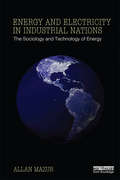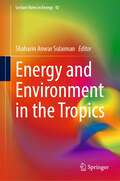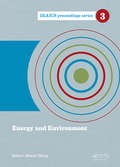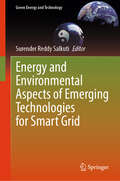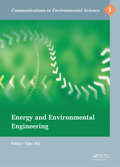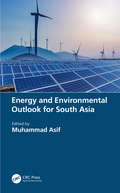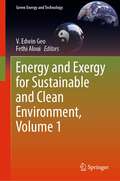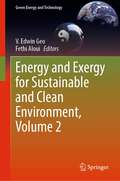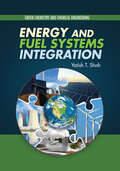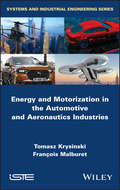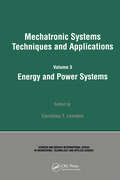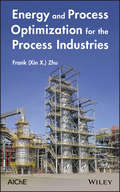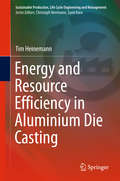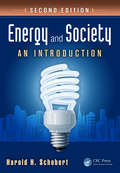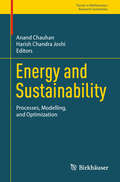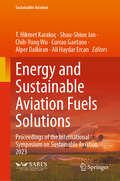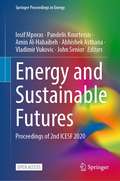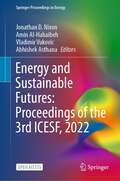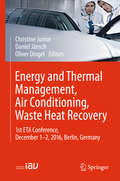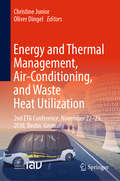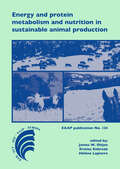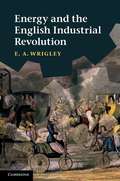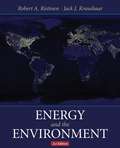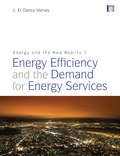- Table View
- List View
Energy and Electricity in Industrial Nations: The Sociology and Technology of Energy
by Allan MazurEnergy is at the top of the list of environmental problems facing industrial society, and is arguably the one that has been handled least successfully, in part because politicians and the public do not understand the physical technologies, while the engineers and industrialists do not understand the societal forces in which they operate. In this book, Allan Mazur, an engineer and a sociologist, explains energy technologies for nontechnical readers and analyses the sociology of energy. The book gives an overview of energy policy in industrialised countries including analysis of climate change, the development of electricity, forms of renewable energy and public perception of the issues. Energy is a key component to environment policy and to the workings of industrial society. This novel approach to energy technology and policy makes the book an invaluable inter-disciplinary resource for students across a range of subjects, from environmental and engineering policy, to energy technology, public administration, and environmental sociology and economics.
Energy and Environment in the Tropics (Lecture Notes in Energy #92)
by Shaharin Anwar SulaimanThe tropical zones are dominated by developing countries, which mainly face problematic environmental issues. Different than four-season countries, tropical countries have a continuous summer-like season and therefore they are rich in clean energy sources like solar and biomass. Hence, the mitigations of environment and energy issues in the tropics would require specific understanding and different approach to solutions. This book offers an assortment of studies on scenarios of environment as well as energy demand and power generation technologies in the tropics. Many of the countries within the tropics are highly populated, and this results in various problems related to the environment and energy. The demand for energy in these countries keeps increasing but concurrently there are also environmental issues that require serious attention. As the global concern on the environment is alarming today, the choice of power generation should be of the cleanest possible resource. This various reports on research activities carried out in the tropics on the aspect of environment and energy presented in this book are highly beneficial for those who like to see an improvement in the tropics with regard to environment and energy systems.
Energy and Environment: Proceedings of the 2014 International Conference on Energy and Environment (ICEE 2014), June 26-27, Beijing, China (IRAICS Proceedings)
by Dawei ZhengThe 2014 International Conference on Energy and Environment (ICEE 2014) was held June 26-27 in Beijing, China. The objective of ICEE 2014 was to provide a platform for researchers, engineers, academics as well as industry professionals from all over the world to present their research results and development activities in Energy and Environment res
Energy and Environmental Aspects of Emerging Technologies for Smart Grid (Green Energy and Technology)
by Surender Reddy SalkutiThis book presents mathematical models of various renewable energy sources (RESs) such as wind energy systems, solar PV systems, battery energy storage systems, pumped-storage hydropower, biomass, and electric vehicles (EVs). It also discusses the challenging task of the integration of high penetration of renewable energies and EVs within existing power systems. The uncertainty related to RESs, electric vehicle charging, and load demands is also modelled. The book provides illustrative and comprehensive practical case studies to enable a complete understanding of the proposed methodologies. This book will consider the nuances of all these new paradigms, smart grid components, technology, and the impact of energy storage, EVs, and distributed energy resources, in the power networks.
Energy and Environmental Engineering: Proceedings of the 2014 International Conference on Energy and Environmental Engineering (ICEEE 2014), September 21-22, 2014, Hong Kong (Communications in Environmental Science)
by Yijin WuThe 2014 International Conference on Energy and Environmental Engineering (ICEEE 2014) was held September 21-22, 2014 in Hong Kong. This proceedings volume assembles papers from various professionals, leading researchers, engineers, scientists and students and presents innovative ideas and research results focused on Energy and Environmental Engine
Energy and Environmental Outlook for South Asia
by Asif MuhammadSouth Asia constitutes a key geography in the world today considering its large population and related daunting energy and environmental challenges. Many countries in the region are faced with a growing gap between energy demand and local resources, resulting in an increased dependence on imports. According to the International Energy Agency (IEA), the energy demand in South Asia will grow at a rate more than double that of the world average in the coming decades. This book addresses the critical subject of energy and environmental outlook for South Asia and presents the wider challenges and the responses at the national and regional level. Features: Discusses and addresses the ongoing energy and environmental challenges faced by almost a quarter of the global population Includes dedicated chapters for each country and presents analysis and recommendations by regional experts Examines how deteriorating air quality and persistent natural disasters are severe environmental challenges for the region Discusses the implications of global warming and climate change for South Asia Includes practical case studies throughout Energy and Environmental Outlook for South Asia will benefit a wide range of stakeholders from various fields including but not limited to energy, environment, economics, national security, and sustainable development. It also serves as a valuable resource for academics, researchers, analysts, policymakers, and representatives of utilities, industry, professional bodies, financial institutions, think tanks, and developmental organizations to better plan their initiatives, activities, and policies. It will help countries in the region and also those around the world by learning from shared experience, and ideally by collaborating for energy and environmental prosperity.
Energy and Exergy for Sustainable and Clean Environment, Volume 1 (Green Energy and Technology)
by Fethi Aloui V. Edwin GeoThis multi-disciplinary book presents the most recent advances in exergy, energy, and environmental issues. Volume 1 focuses on fundamentals in the field and covers current problems, future needs, and prospects in the area of energy and environment from researchers worldwide. Based on some selected lectures from the Eleventh International Exergy, Energy and Environmental Symposium (IEEES-11) and complemented by further invited contributions, this comprehensive set of contributions promote the exchange of new ideas and techniques in energy conversion and conservation in order to exchange best practices in "energetic efficiency." Included are fundamental and historical coverage of the green transportation and sustainable mobility sectors, especially regarding the development of sustainable technologies for thermal comforts and green transportation vehicles. Furthermore, contributions on renewable and sustainable energy sources, strategies for energy production, and the carbon-free society constitute an important part of this book.
Energy and Exergy for Sustainable and Clean Environment, Volume 2 (Green Energy and Technology)
by Fethi Aloui V. Edwin GeoThis multi-disciplinary book presents the most recent advances in exergy, energy, and environmental issues. Volume 2 focuses on fundamentals in the field and covers current problems, future needs, and prospects in the area of energy and environment from researchers worldwide. Based on some selected lectures from the Eleventh International Exergy, Energy and Environmental Symposium (IEEES-11) and complemented by further invited contributions, this comprehensive set of contributions promote the exchange of new ideas and techniques in energy conversion and conservation in order to exchange best practices in "energetic efficiency." Included are fundamental and historical coverage of the green transportation and sustainable mobility sectors, especially regarding the development of sustainable technologies for thermal comforts and green transportation vehicles. Furthermore, contributions on renewable and sustainable energy sources, strategies for energy production, and the carbon-free society constitute an important part of this book.
Energy and Fuel Systems Integration (Green Chemistry And Chemical Engineering Ser.)
by Yatish T. ShahEnergy and Fuel Systems Integration explains how growing energy and fuel demands, paired with the need for environmental preservation, require different sources of energy and fuel to cooperate and integrate with each other rather than simply compete. Providing numerous examples of energy and fuel systems integration success stories, this book:Discu
Energy and Motorization in the Automotive and Aeronautics Industries
by François Malburet Tomasz KrysinskiThe book is intended for students in engineering school or university, young engineers or newcomers in the automotive industry or aeronautics. The objective is to describe in a simple and clear way the problem of energy and motorization for the automobile, helicopters or airplanes. The front-end treatment of these industrial sectors makes it possible to analyze in an original way the similarities and differences of these different means of transport. For this, and based on current technologies and tomorrow, it specifically describes the problem of the energy requirement of cars and aircraft. The result is a search for an ideal motorization associated with the behavior of these different means of transport followed by the analysis of the performances of the various types of engines by covering gas turbines, internal combustion engines and electric motors. Transmission elements such as aerospace gearboxes or gearboxes are described as well as a chapter on energy storage means and their performance including batteries, supercapacitors, inertial or pneumatic storage, hydrogen or fuels from fossil fuels. A final chapter shows the interest and prospects of energy hybridization and electrification for the progressive replacement of fossil fuels. Beyond the technological descriptions, the book focuses on proposing basic sizing rules in order to justify certain performances and to give the reader the means to appropriate the basic know-how of these industrial sectors.
Energy and Power Systems
by Cornelius T. LeondesThe technical committee on mechatronics formed by the International Federation for the Theory of Machines and Mechanisms, in Prague, Czech Republic, adopted the following definition for the term: Mechatronics is the synergistic combination of precision mechanical engineering, electronic control and systems thinking in the design products and manufa
Energy and Process Optimization for the Process Industries
by Frank ZhuExploring methods and techniques to optimize processing energy efficiency in process plants, Energy and Process Optimization for the Process Industries provides a holistic approach that considers optimizing process conditions, changing process flowschemes, modifying equipment internals, and upgrading process technology that has already been used in a process plant with success. Field tested by numerous operating plants, the book describes technical solutions to reduce energy consumption leading to significant returns on capital and includes an 8-point Guidelines for Success. The book provides managers, chemical and mechanical engineers, and plant operators with methods and tools for continuous energy and process improvements.
Energy and Resource Efficiency in Aluminium Die Casting
by Tim HeinemannThis monograph provides a field-proven approach to analyze industrial production with a cross-company scope as well as regarding all hierarchical system levels of manufacturing enterprises. The book exemplifies this approach in the context of aluminum die casting, and presents a set of measures which allow a 30 percent energy reduction along the value chain. The target audience primarily comprises researchers and experts in the field but the book may also be beneficial for graduate students.
Energy and Society: An Introduction, Second Edition
by Harold H. SchobertEnergy and Society: An Introduction, Second Edition provides readers with a detailed introduction to energy sources and energy utilization. This book presents an overview of alternative energy issues and technologies, discusses the pros and cons of various energy sources, and explores their impacts on society and the environment.What's New in the S
Energy and Spectrum Efficient Wireless Network Design
by Guowang Miao Guocong SongCovering the fundamental principles and state-of-the-art cross-layer techniques, this practical guide provides the tools needed to design MIMO- and OFDM-based wireless networks that are both energy- and spectrum-efficient. Technologies are introduced in parallel for both centralized and distributed wireless networks to give you a clear understanding of the similarities and differences between their energy- and spectrum-efficient designs, which is essential for achieving the highest network energy saving without losing performance. Cutting-edge green cellular network design technologies, enabling you to master resource management for next-generation wireless networks based on MIMO and OFDM, and detailed real-world implementation examples are provided to guide your engineering design in both theory and practice. Whether you are a graduate student, a researcher or a practitioner in industry, this is an invaluable guide.
Energy and Sustainability: Processes, Modelling and Optimization (Trends in Mathematics)
by Anand Chauhan Harish Chandra JoshiThis volume addresses SDG 7 (Affordable and Clean Energy) and SDG 12 (Sustainable Consumption and Production). By 2030, therefore, people have to substantially increase their share of renewable energy. The book focuses on waste as primary sources of biomass that can fulfill energy requirements for sustainable development. It also discusses various related topics such as energy production methods, a mathematical model for the development of a sustainable biofuels supply chain, economic analysis, optimization techniques, multiple-criteria decision-making and mixed-integer linear programming and existing and emerging policies that encourage the switch to renewable energy. It is committed to fusing science and technology in a way that assures a sustainable future and addresses major topics on biofuels: biomass, bioenergy, biodiesel, bioethanol, biogas modelling and their supply chain management, inventory control and optimization.The 2030 Agenda for Sustainable Development, adopted by all United Nations Member countries in 2015, provides a shared blueprint for peace and prosperity for people and the planet, now and into the future. The book uses an interdisciplinary approach and provides solutions to energy requirements by using emerging technology and nanotechnologies. It explores a technical breakdown of the tools that may be utilized to convert biomass into usable energy forms. At the end of the book, a description of the social and economic aspects of renewable energy and minimization of bioenergy cost is presented. The book is useful to students, researchers, industry experts and anybody in the adoption of renewable energy. It covers the complete course in the fundamentals of biomass feedstock and their supply chain management resources at the graduate level in engineering.
Energy and Sustainable Aviation Fuels Solutions: Proceedings of the International Symposium on Sustainable Aviation 2023 (Sustainable Aviation)
by Alper Dalkiran Ali Haydar Ercan T. Hikmet Karakoç Shau-Shiun Jan Chih-Yung Wu Currao GaetanoSustainable aviation is a long-term strategy to provide innovative solutions to the aviation industry's challenges. The International Symposium on Sustainable Aviation is a multi-disciplinary symposium that presents research on sustainability-based issues and future trends in aviation from an economic, social, and environmental perspective. The conference provides a platform offering insights on a broad range of current topics in aviation, such as improving aircraft fuel efficiency, fostering the use of biofuels, minimizing environmental impact, mitigating GHG emissions, and reducing engine and airframe noise. ISEAS allows researchers, scientists, engineers, practitioners, policymakers, and students to exchange information, present new technologies, and developments. Also, discuss future direction, strategies, and priorities in aviation and sustainability.
Energy and Sustainable Futures: Proceedings of 2nd ICESF 2020 (Springer Proceedings in Energy)
by John Senior Iosif Mporas Pandelis Kourtessis Amin Al-Habaibeh Abhishek Asthana Vladimir VukovicThis open access book presents papers displayed in the 2nd International Conference on Energy and Sustainable Futures (ICESF 2020), co-organised by the University of Hertfordshire and the University Alliance DTA in Energy. The research included in this book covers a wide range of topics in the areas of energy and sustainability including:• ICT and control of energy;• conventional energy sources;• energy governance;• materials in energy research;• renewable energy; and• energy storage.The book offers a holistic view of topics related to energy and sustainability, making it of interest to experts in the field, from industry and academia.
Energy and Sustainable Futures: Proceedings of the 3rd ICESF, 2022 (Springer Proceedings in Energy)
by Amin Al-Habaibeh Abhishek Asthana Vladimir Vukovic Jonathan D. NixonThis is an open access book. This book contains research papers presented at the 3rd International Conference on Energy and Sustainable Futures (ICESF), which took place at Coventry University, UK, in 2022. The ICESF is an annual conference organised by the UK-based Doctorial Training Alliance (DTA) programme. It is a multidisciplinary conference focused on addressing the future challenges and opportunities for meeting global energy targets and sustainable development goals. The conference brought together academic researchers, industry experts and research students to showcase the latest innovations and research on a wide range of topics in the areas of energy and sustainability, including • renewable energy; • ICT and control; • computational fluid dynamics; • optimization; • conventional energy sources; • energy governance; • materials in energy research; • energy storage and • energy access.
Energy and Thermal Management, Air Conditioning, Waste Heat Recovery
by Christine Junior Daniel Jänsch Oliver DingelThe volumes includes selected and reviewed papers from the 1st ETA Conference on Energy and Thermal Management, Air Conditioning and Waste Heat Recovery in Berlin, December 1-2, 2016. Experts from university, public authorities and industry discuss the latest technological developments and applications for energy efficiency. Main focus is on automotive industry, rail and aerospace.
Energy and Thermal Management, Air-Conditioning, and Waste Heat Utilization: Proceedings Of The 2nd Eta Conference, November 22-23, 2018, Berlin (Proceedings In Automotive Engineering Ser.)
by Christine Junior Oliver DingelThe volumes includes selected and reviewed papers from the 2nd ETA Conference on Energy and Thermal Management, Air Conditioning and Waste Heat Recovery in Berlin, November 22-23, 2018. Experts from university, public authorities and industry discuss the latest technological developments and applications for energy efficiency. Main focus is on automotive industry, rail and aerospace.
Energy and protein metabolism and nutrition in sustainable animal production
by Ermias Kebreab James W. Oltjen Hélène LapierreAs world population increases, demand for food and particularly animal products is expected to grow substantially. Because of limited area for expansion of animal agriculture and growing consumer concern for the environmental impact of animal production, gains in animal efficiency will have to be part of the solution. This book addresses key issues of how energy and protein are utilized and interact in farm animals from the molecular to the whole animal and even to the herd or group level of organization. It contains state-of-the-art research and reviews on several topics of nutrient utilization and metabolism from top scientists worldwide. Key issues addressed include energy/protein interactions, methodology such as in vitro and in vivo techniques, regulation including pre-natal programming and endocrine regulation, modeling and systems biology (including a tribute to the late Professor R. Lee Baldwin of the University of California, Davis, a leader in the field), products and health of animals, tissue metabolism, and environmental sustainability in agriculture. This book is a valuable resource for researchers, students, policy makers, producers and industry professionals believing that a better understanding of metabolism and nutrition of farm animals is part of the solution.
Energy and the English Industrial Revolution
by E. A. WrigleyThe industrial revolution transformed the productive power of societies. It did so by vastly increasing the individual productivity, thus delivering whole populations from poverty. In this new account by one of the world's acknowledged authorities the central issue is not simply how the revolution began but still more why it did not quickly end. The answer lay in the use of a new source of energy. Pre-industrial societies had access only to very limited energy supplies. As long as mechanical energy came principally from human or animal muscle and heat energy from wood, the maximum attainable level of productivity was bound to be low. Exploitation of a new source of energy in the form of coal provided an escape route from the constraints of an organic economy but also brought novel dangers. Since this happened first in England, its experience has a special fascination, though other countries rapidly followed suit.
Energy and the Environment
by Robert A. Ristinen Jack P. KraushaarEnergy and the Environment deals with the core subjects of energy and the environment. With respect to energy, the authors have tried to cover the basic concepts, resources, applications, and problems of current interest. With respect to the environment, they have included most of the major concern.
Energy and the New Reality 1: Energy Efficiency and the Demand for Energy Services
by Danny HarveyReducing and managing humanity's demand for energy is a fundamental part of the effort to mitigate climate change. In this, the most comprehensive textbook ever written on the subject, L.D. Danny Harvey lays out the theory and practice of how things must change if we are to meet our energy needs sustainably. The book begins with a succinct summary of the scientific basis for concern over global warming, then outlines energy basics and current patterns and trends in energy use. This is followed by a discussion of current and advanced technologies for the generation of electricity from fossil fuels. The book then considers in detail how energy is used, and how this use can be dramatically reduced, in the following end-use sectors: - buildings - transportation - industry - food and agriculture - municipal services The findings from these sector-by-sector assessments are then applied to generate scenarios of how global energy demand could evolve over the coming decades with full implementation of the identified and economically-feasible energy-saving potential. The book ends with a brief discussion of policies that can be used to reduce energy demand, but also addresses the limits of technologically-based improvements in efficiency in moderating demand and of the need to re-think some of our underlying assumptions concern ends with a brief discusing what we really need. Along with its companion volume on C-free energy supply, and accompanied by extensive supplementary online material, this is an essential resource for students and practitioners in engineering, architecture, environment and energy related fields. Online material includes: Excel-based computational exercises, teaching slides for each chapter, links to free software tools.
